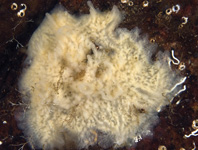Abstract
A new species of the bee genus Rhathymus Lepeletier & Serville, 1828 is described and figured as Rhathymus atitlanicus Ayala, Hinojosa-Díaz and Armas-Quiñonez. The new species is from the department of Sololá, Guatemala, and can be distinguished based on the black integument contrasting with the orange color of the wings.
References
Brooks, R.W. (1988) Systematics and Phylogeny of the Anthophorine Bees (Hymenoptera: Anthophoridae; Anthophorini). The University of Kansas Science Bulletin, 53 (9), 436–575.
Camargo, J.M.F., Zucchi, R. & Sakagami, S.F. (1975) Observations on the bionomics of Epicharis (Epicharana) rustica flava (Olivier) including notes on its parasite Rhathymus sp. (Hymenoptera, Apoidea: Anthophoridae). Studia Entomologia, 18, 313–340.
Cardinal, S., Straka, J. & Danforth, B.N. (2010) Comprehensive phylogeny of apid bees reveals the evolutionary origins and antiquity of cleptoparasitism. Proceedings of the National Academy of Sciences, 107 (37), 16207–16211.
https://doi.org/10.1073/pnas.1006299107
Friese, H. (1912) Neue und wenig bekannte Bienenarten der neotropischen Region. Archiv für Naturgeschichte, Abteilung A, 78 (5), 198–226.
Engel, M.S., Michener, C.D. & Rightmyer, M.G. (2004a) The cleptoparasitic bee tribe Rhathymini (Hymenoptera: Apidae): Description of a new genus and a tribal review. Journal of Hymenoptera Research, 13 (1), 1–12.
Engel, M.S., Michener, C.D. & Rightmyer, M.G. (2004b) A replacement name for the cleptoparasitic bee genus Rhathymodes (Hymenoptera: Apidae). Journal of Hymenoptera Research, 13 (2), 316.
Hiller, B. & Wittmann, D. (1994) Seasonality, nesting biology and mating behavior of the oil-collecting bee Epicharis dejeanii. Biociências, 2, 107–124.
Michener, C.D. (1944) Comparative external morphology, phylogeny, and a classification of the bees. Bulletin of the American Museum of Natural History, 82, 151–326.
Michener, C.D. (2007) The bees of the world. 2nd edition, Johns Hopkins University Press, Baltimore, Maryland, xvi + [1] + 953 pp.
Moure, J.S. & Melo, G.A.R. (2012) Rhathymini Lepeletier, 1841. In: Moure, J.S., Urban, D. & Melo, G.A.R. (Eds.), Catalogue of Bees (Hymenoptera, Apoidea) in the Neotropical Region. Available from: http://www.moure.cria.org.br/catalogue (accessed 29 June 2017)
Roig-Alsina, A. & Michener, C.D. (1993) Studies of the phylogeny and classification of long-tongued bees. University of Kansas Science Bulletin, 55, 124–162.
https://doi.org/10.5962/bhl.part.775
Rozen, J.G. (1969) The larvae of Anthophoridae (Hymenoptera, Apoidea), Part 3. The Melectini, Ericrocini, and Rhathymini. American Museum Novitates, No. 2382, 1–24.
Rozen, J.G. (1991) Evolution of cleptoparasitism in anthophorid bees as revealed by their mode of parasitism and first instars. American Museum Novitates, No. 3029, 1–36.
Werneck, H.A., Melo, G.A.R. & Campos, L.A.O. (2012) First host record for the cleptoparasitic bee Rhathymus friesei Ducke (Hymenoptera, Apidae). Revista Brasileira de Entomologia, 56 (4), 519–521.
https://doi.org/10.1590/S0085-56262012000400021

